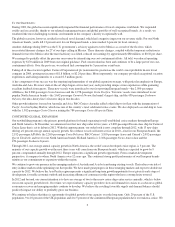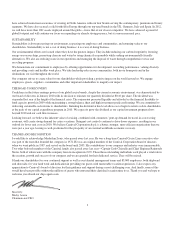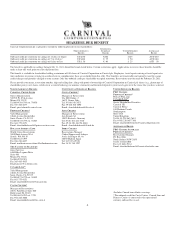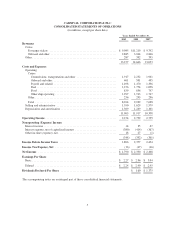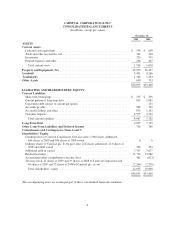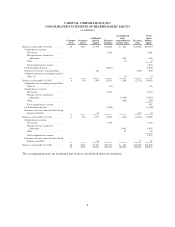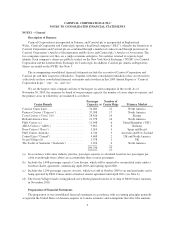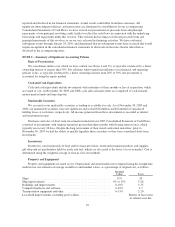Carnival Cruises 2009 Annual Report Download - page 12
Download and view the complete annual report
Please find page 12 of the 2009 Carnival Cruises annual report below. You can navigate through the pages in the report by either clicking on the pages listed below, or by using the keyword search tool below to find specific information within the annual report.Ship improvement costs that we believe add value to our ships are capitalized to the ships and depreciated
over their or the ships’ estimated remaining useful life, whichever is shorter, while costs of repairs and
maintenance, including minor improvement costs, are charged to expense as incurred. We capitalize interest as
part of acquiring ships and other capital projects during their construction period. The specifically identified or
estimated cost and accumulated depreciation of previously capitalized ship components are written off upon
retirement.
Dry-dock costs primarily represent planned major maintenance activities that are incurred when a ship is
taken out of service for scheduled maintenance. These costs are expensed as incurred.
We review our long-lived assets for impairment whenever events or changes in circumstances indicate that
the carrying amounts of these assets may not be fully recoverable. The assessment of possible impairment is
based on our ability to recover the carrying value of our asset based on our estimate of its undiscounted future
cash flows. If these estimated undiscounted future cash flows are less than the carrying value of the asset, an
impairment charge is recognized for the excess, if any, of the asset’s carrying value over its estimated fair value.
Goodwill and Trademarks
We review our goodwill for impairment annually, and, when events or circumstances dictate, more
frequently. All of our goodwill has been allocated to our cruise line reporting units. Our goodwill impairment
reviews consist of a two-step process. The first step is to determine the fair value of the reporting unit and
compare it to the carrying value of the net assets allocated to the reporting unit. If this fair value exceeds the
carrying value no further analysis or goodwill write-down is required. The second step is required if the fair
value of the reporting unit is less than the carrying value of the net assets. In this step the estimated fair value of
the reporting unit is allocated to all the underlying assets and liabilities, including both recognized and
unrecognized tangible and intangible assets, based on their relative fair values. If necessary, goodwill is then
written-down to its implied fair value.
The costs of developing and maintaining our trademarks are expensed as incurred. For certain of our
acquisitions we have allocated a portion of the purchase prices to the acquiree’s identified trademarks.
Trademarks are estimated to have an indefinite useful life and, therefore, are not amortizable, but are reviewed
for impairment annually, and, when events or circumstances dictate, more frequently. Our trademarks would be
considered impaired if their carrying value exceeds their estimated fair value.
Revenue and Expense Recognition
Guest cruise deposits represent unearned revenues and are initially recorded as customer deposit liabilities
when received. Customer deposits are subsequently recognized as cruise revenues, together with revenues from
onboard and other activities (which include transportation and shore excursion revenues), and all associated
direct costs of a voyage are recognized as cruise expenses, upon completion of voyages with durations of ten
nights or less and on a pro rata basis for voyages in excess of ten nights. Future travel discount vouchers issued to
guests are typically recorded as a reduction of cruise passenger ticket revenues when such vouchers are
utilized. Cancellation fees are recognized in cruise passenger ticket revenues at the time of the cancellation.
Our sale to guests of air and other transportation to and from our ships and the related cost of purchasing
this service are recorded as cruise passenger ticket revenues and cruise transportation costs, respectively. The
proceeds that we collect from the sale of third party shore excursions and on behalf of onboard concessionaires,
net of the amounts remitted to them, are recorded as concession revenues, on a net basis, in onboard and other
cruise revenues.
Revenues and expenses from our tour and travel services are recognized at the time the services are
performed or expenses are incurred.
11



